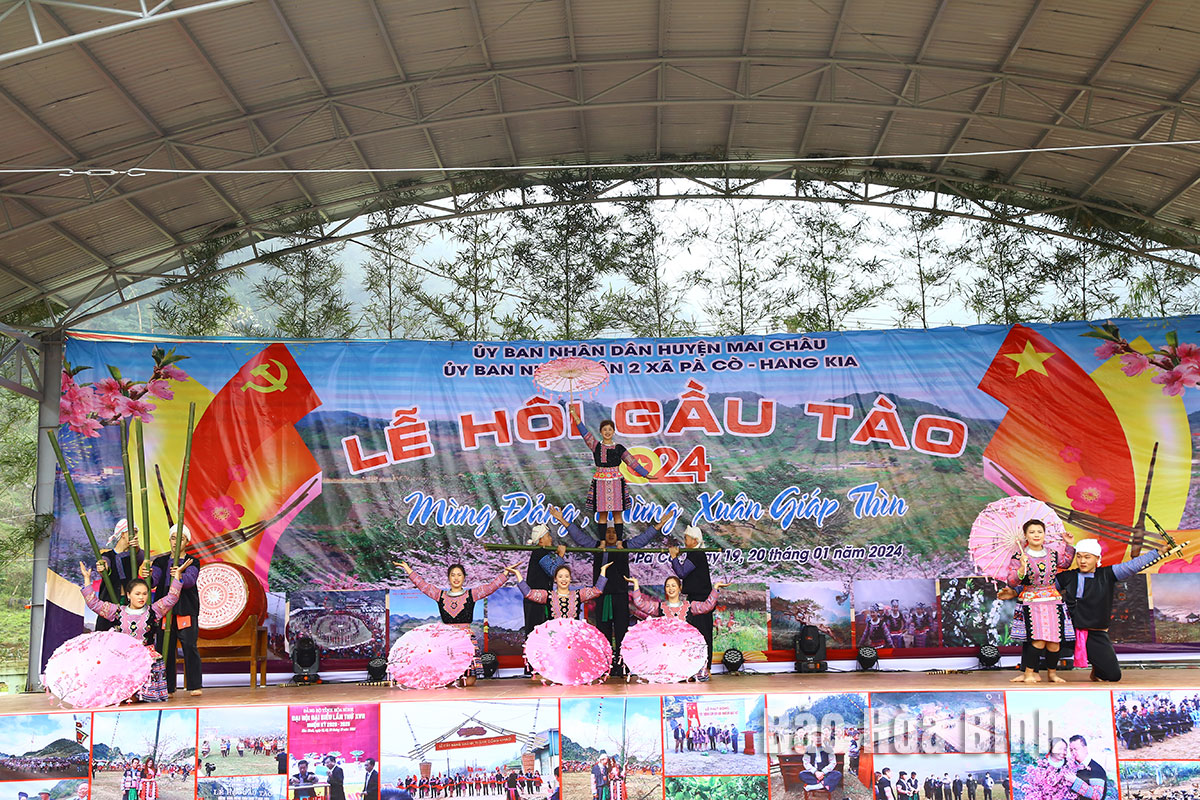



The special musical performances at the festival.
The special musical performances at the festival. The ritual of worshiping next to Neu (bamboo) tree prays for the gods to bless the new year with good weather and good harvests, wishing everyone and every family peace, happiness and health. Mong ethnic people in the two communes, Pa Co and Hang Kia, belong to the Mong ethnic community in Vietnam, however, they belong to two different Mong lineages. Mong ethnic people in Pa Co commune are Black Mong (often called Mong Du) and the Mong ethnic people in Hang Kia commune are Mong Hoa (often called Mong Lenh). In the two communes, there are currently over 6,200 people living in 11 hamlets. Gau Tao Festival is a traditional folk festival with a long-standing cultural and religious activity and it has been restored since 2017. The festival consists of 2 parts: the ceremony and the festival. The ceremony takes place with the main ritual of erecting Neu tree. Neu tree in Gau Tao festival carries the symbol of the sacred tree connecting the heaven and the earth. During the worshiping ceremony, the officiant lights incense and worships around Neu tree, praying for the gods to bless the new year with good weather and good harvests, wishing everyone and every home peace, happiness, and health... Right after the sounded drum to start the festival, the people started the traditional round dance of Mong ethnic people around Neu tree. The festival takes place with many unique and attractive activities such as the musical performances imbued with the national cultural identity performed by Mong boys and girls, visiting the stalls of food, agricultural products, and typical products of Mong ethnic people, competing in folk games, traditional sports of Pao throwing, TuLlu fighting, stilt walking, and Khen dancing, pounding contest of Day cakes, the contest of the national costume... Being excited with the contest of pounding Day cakes. The local people are excited to take part in Pao thowing The organization of Gau Tao festival contributes to conserving, preserving, promoting and honoring the cultural identity of Mong ethnic people. At the same time, it promotes and introduces the history, culture and tourism potential of the two communes, Pa Co and Hang Kia, to domestic and foreign tourists. The festival meets the aspirations and the spiritual life of the people of the 2 communes, building a healthy cultural and spiritual life, creating a joyful and exciting atmosphere to welcome the New Year of the Dragon, 2024... Gau Tao Festival of Mong ethnic group in Pa Co and Hang Kia communes in 2024 takes place on January 19th – 20th.
The ritual of worshiping next to Neu (bamboo) tree prays for the gods to bless the new year with good weather and good harvests, wishing everyone and every family peace, happiness and health.
Mong ethnic people in the two communes, Pa Co and Hang Kia, belong to the Mong ethnic community in Vietnam, however, they belong to two different Mong lineages. Mong ethnic people in Pa Co commune are Black Mong (often called Mong Du) and the Mong ethnic people in Hang Kia commune are Mong Hoa (often called Mong Lenh). In the two communes, there are currently over 6,200 people living in 11 hamlets.
Gau Tao Festival is a traditional folk festival with a long-standing cultural and religious activity and it has been restored since 2017. The festival consists of 2 parts: the ceremony and the festival. The ceremony takes place with the main ritual of erecting Neu tree. Neu tree in Gau Tao festival carries the symbol of the sacred tree connecting the heaven and the earth. During the worshiping ceremony, the officiant lights incense and worships around Neu tree, praying for the gods to bless the new year with good weather and good harvests, wishing everyone and every home peace, happiness, and health... Right after the sounded drum to start the festival, the people started the traditional round dance of Mong ethnic people around Neu tree.
The festival takes place with many unique and attractive activities such as the musical performances imbued with the national cultural identity performed by Mong boys and girls, visiting the stalls of food, agricultural products, and typical products of Mong ethnic people, competing in folk games, traditional sports of Pao throwing, TuLlu fighting, stilt walking, and Khen dancing, pounding contest of Day cakes, the contest of the national costume...
The organization of Gau Tao festival contributes to conserving, preserving, promoting and honoring the cultural identity of Mong ethnic people. At the same time, it promotes and introduces the history, culture and tourism potential of the two communes, Pa Co and Hang Kia, to domestic and foreign tourists. The festival meets the aspirations and the spiritual life of the people of the 2 communes, building a healthy cultural and spiritual life, creating a joyful and exciting atmosphere to welcome the New Year of the Dragon, 2024...